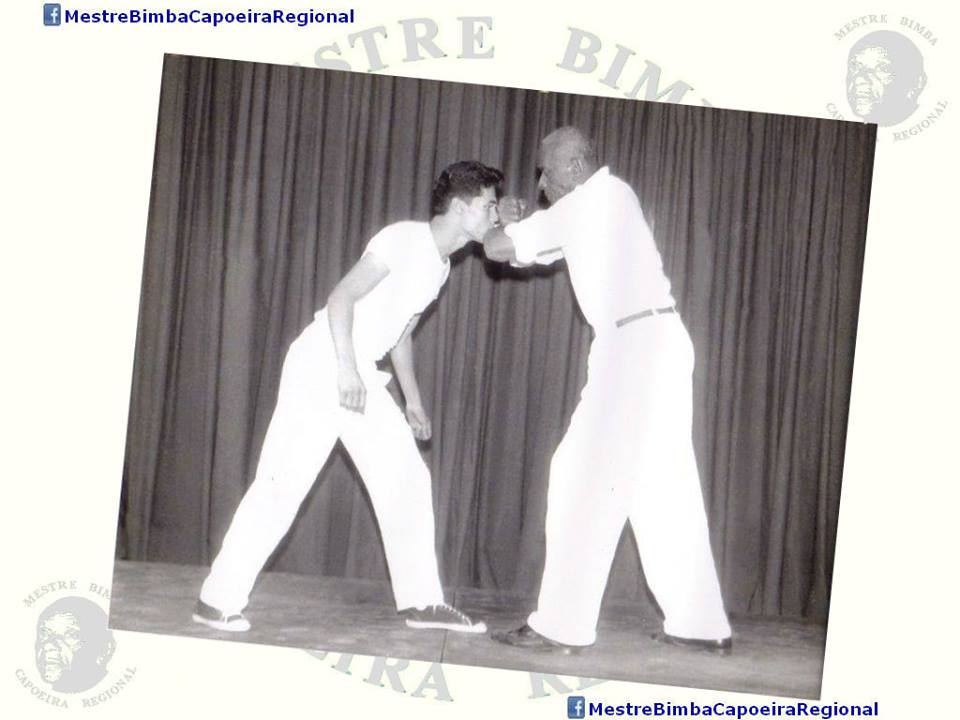
https://www.youtube.com/watch?v=evi4aKAUiEc
The Bahian Rooster+Seduction1 cabeçadas (see my article and video) were so popular in old Bahian capoeira game that special counters were developed against them. I will describe them below.
Note: These counters do not work against Tiger cabeçadas; only against Rooster+Seduction1 cabeçadas.
Note: These technique only make sense in a capoeira where (Bahian) cabeçadas are commonplace; so they do not make sense in modern capoeira.
A part of the arsenal of old Bahian cabeçadas is a hand technique called Leque(fan), probably also known as Boca de siri(crab's mouth). It is a squeeze of the open palm (using Eagle archetype); done against opponent's cabeçada attack.
Leque has the effect of twisting opponent's head and thus misaligning his power line, disrupting the cabeçada and throwing him on the ground.
Here is how you do it: When the opponent does a (Rooster+Seduction1) cabeçada, switch to Eagle mechanics; put your palm on his head, grab his skull with your fingers and squeeze. This squeeze, almost marvelously, makes his head twist and takes him to the ground.
(I repeat: Do not try to twist his head! Just squeeze with the Eagle, and the mechanics takes care of the rest)
-
Of course, Leque is applied against Rooster cabeçadas of Bahian capoeira; it is impossible to apply it against a Tiger cabeçadas of Carioca.
Yet in Bahian capoeira, this technique has its charm; it can even be applied while in Au, disrupting opponent's cabeçada that tries to uproot your au!
You execute an Au to the left and the opponent does a straight Rooster+Seduction1 cabeçada to throw you down.
Upside down in au, lift your right hand, grab opponent's skull and squeeze, applying Leque; at the same time, the Eagle archetype twists and arches your body on in the air. The twisting downward movement of your hand twists opponent's head to face upward and against your body; then, the twisting of your body itself will take the opponent down onto his back.
(Note that here, the first half of the head twist is done with your right hand; the second half of the twist is done by the friction of your torso).
This is an interesting Bahian technique. Note that tactically, this is used as a drawing fake; you purposefully do an Au to entice the opponent to do a cabeçada, so you can take him down with the Leque. But this is also true for the other two counters most of the time.
Another interesting counter to Bahian cabeçadas is Bochecho: When the opponent attacks with a (Rooster+Seduction1) cabeçada to your torso, cross your forearms and cross-strike his cheeks with the backs of your fists using Eagle+Seduction1 archetype. At the same time, use a vocalization - a throaty gargling "Kchhhhh!" sound
Done properly and with the vocalization this is a applies a nerve confuser; neutralizing the cabeçada and making the opponent very disoriented for about 20 seconds.
Take advantage of the nerve confuser and at the same time, step forth with one leg; this takes the dizzy opponent down.
Note: Bochecho means 'mouth washing' in portuguese. This does not refer to you 'washing' opponent's face with your hands! Instead, it refers to the vocalization you have to make to create the nerve confuser; which is very similar to the sound made by gargling when rinsing your mouth.
Note that doing Bochecho without the vocalization only results in nerve strangle; the above makes it clear that the old capoeiras knew about the power of the vocalization.
Note: Mestre Bimba shows this technique in his 'Curso de capoeira Regional', which means he knew it. However, he completely ommits the sound you need to make, and the follow-up takedown.
Warning: Applying nerve confusers repeatedly can kill the opponent via a nerve shock! Always wait until the effect of the previous nerve confuser dissipates before applying another one.
Note that the video version does not mention the vocalization; this is by design. People who are too lazy to read this article will simply not learn the nerve confuser.
-
Conclusion
As noted above, these three cabecada counters were an integral part of old Bahian Capoeira game; which used a lot of cabeçadas. Clearly, they are (almost - but more of that elsewhere) unusable in self-defence; as nobody is going to attack you with Bahian cabeçada on the street.
Still, they are interesting techniques that illustrate the way old Bahian capoeira was played.
-
Below, Bimba applies Bochecho(1960s)

This Web Page was Built with PageBreeze Free HTML Editor